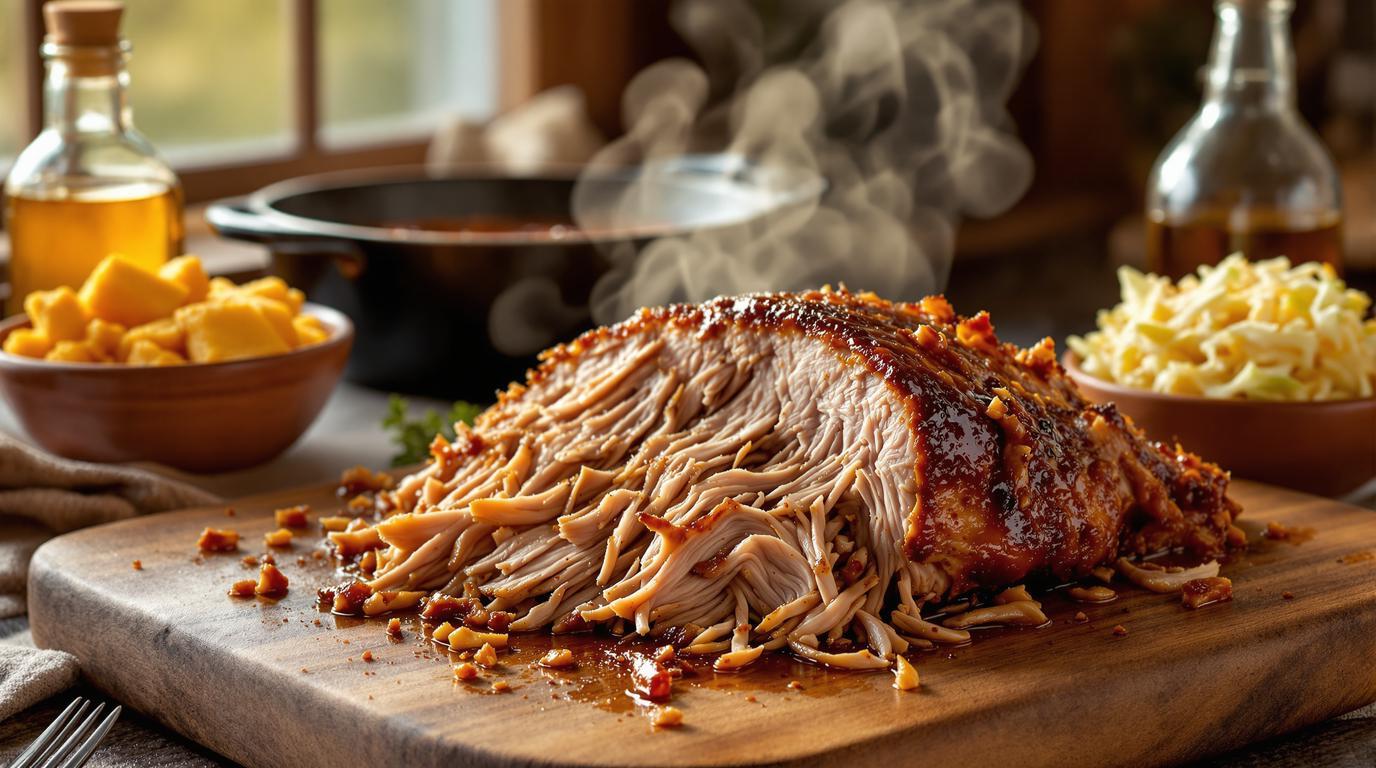There’s something almost magical about pulling the lid off a slow cooker after a full day of patient cooking. The cloud of savory steam that greets you, carrying aromas that have been developing for hours, is one of life’s simple pleasures. I learned the art of pulled pork from my grandmother, who would rise before dawn on special occasions to prepare what would become the centerpiece of our family gatherings. “Low and slow is the only way to honor the pig,” she’d tell me, gently rocking in her kitchen chair as the house filled with intoxicating smells of vinegar, spices, and slow-rendering pork fat. This Carolina-style pulled pork recipe captures that patient, deliberate approach that transforms a humble cut into something truly extraordinary.
The Southern Heritage of Pulled Pork 📖
Long before backyard barbecues became weekend standards, Southern communities would gather for whole-hog cookouts that served as both celebration and necessity. Dating back to pre-Civil War times, these events utilized every part of the animal, with the shoulder becoming particularly prized for its perfect balance of fat and meat. The regional variations tell a story of American ingenuity – Eastern North Carolina’s tangy vinegar-based approach contrasting with Western Carolina’s slightly sweeter tomato-tinged sauces. What unites them all is respect for the low-temperature, extended cooking process that transforms collagen into silky gelatin.
During my years cooking professionally, I’ve prepared pulled pork countless ways, but I always return to grandmother’s method – a 10-12 hour slow roast that requires little technical skill but abundant patience. The reward is pork so tender it practically pulls itself.
The Building Blocks of Perfect Pulled Pork 🧾
Success begins with selecting the right cut. A 4-6 pound (1.8-2.7kg) bone-in pork shoulder (sometimes labeled “Boston butt”) provides the ideal fat content and connective tissue. The generous marbling slowly renders during cooking, essentially self-basting the meat. For the dry rub, we balance 2 tablespoons coarse sea salt, 1 teaspoon black pepper, 2 tablespoons smoked paprika, 1 tablespoon garlic powder, 1 teaspoon mustard powder, and ½ teaspoon red pepper flakes.
The cooking liquid – 2 cups of apple cider vinegar combined with 2 tablespoons maple syrup – creates the distinctive tangy foundation that defines Carolina-style pulled pork. This acid-forward approach helps break down muscle fibers while infusing flavor deep into the meat.
Chef’s Note: While many modern recipes call for searing the meat before slow-cooking, traditional Southern pulled pork skips this step. The extended cooking time at 200°F (93°C) develops plenty of flavor through the Maillard reaction without sacrificing moisture.
The Slow-Cooking Method 📝
1. Pat the pork shoulder dry with paper towels and massage the dry rub mixture thoroughly into all surfaces, working it into crevices and under any fat caps.
2. For exceptional results, refrigerate the seasoned meat uncovered overnight. This dry-brine technique intensifies flavor and improves texture. If time is limited, proceed immediately to cooking.
3. Place the seasoned pork in a Dutch oven or slow cooker. Combine apple cider vinegar and maple syrup, then pour around (not over) the meat to preserve the rub.
4. Cover tightly and cook at 200°F (93°C) for 10-12 hours, or until the meat effortlessly shreds when tested with a fork. If using a slow cooker, set to low.
5. Allow the meat to rest 30 minutes before shredding with two forks, working with the grain rather than against it to maintain perfect texture.
6. Strain the cooking liquid, skim excess fat, and mix a portion back into the shredded meat to taste.
Chef’s Secret Techniques 🤫
The difference between good pulled pork and transcendent pulled pork often comes down to subtle techniques. First, resist the urge to disturb the meat during cooking – each time you lift the lid, you’re adding 15-20 minutes to the cooking time as heat escapes. Second, proper shredding technique is crucial; use a light touch to create substantial strands rather than mincing the meat into oblivion.
If you don’t have access to apple cider vinegar, white vinegar with a tablespoon of apple juice makes an acceptable substitute. Similarly, brown sugar can replace maple syrup, though you’ll lose some of the subtle complexity.
For those looking to expand their summer recipe collection, my Chilled Ramen Revelation offers another beloved family recipe, or try the 15-Minute Caprese Chicken Pasta when time is tight.
Serving & Celebration 🍽️
Traditional service calls for simple, soft buns that won’t compete with the pork’s complex flavors. Offer a vinegar-based sauce on the side rather than drowning the meat – diners can adjust to taste. Classic accompaniments include a crisp, vinegar-dressed coleslaw, homemade baked beans, and cornbread that’s slightly sweet to balance the tangy pork.
For dessert, consider my 2-Ingredient Homemade Ice Pops for a refreshing finish, or pair with Grandmother’s Heavenly Flaky Biscuits topped with honey for a truly Southern experience.
Wine enthusiasts will find that a jammy Zinfandel stands up beautifully to the richness of pulled pork, while beer drinkers might appreciate a malty amber ale or crisp pilsner.
Whenever I prepare this recipe, I’m transported back to my grandmother’s kitchen, where patience wasn’t just a virtue but a necessary ingredient. In our rushed world, there’s something profoundly satisfying about a dish that cannot be hurried – a reminder that some of life’s greatest pleasures come to those willing to wait. Whether you’re feeding a crowd or preparing meals for the week ahead, this pulled pork delivers the soul-warming comfort that defines true Southern hospitality. Try it once, and I guarantee it will become part of your family’s culinary heritage too.
